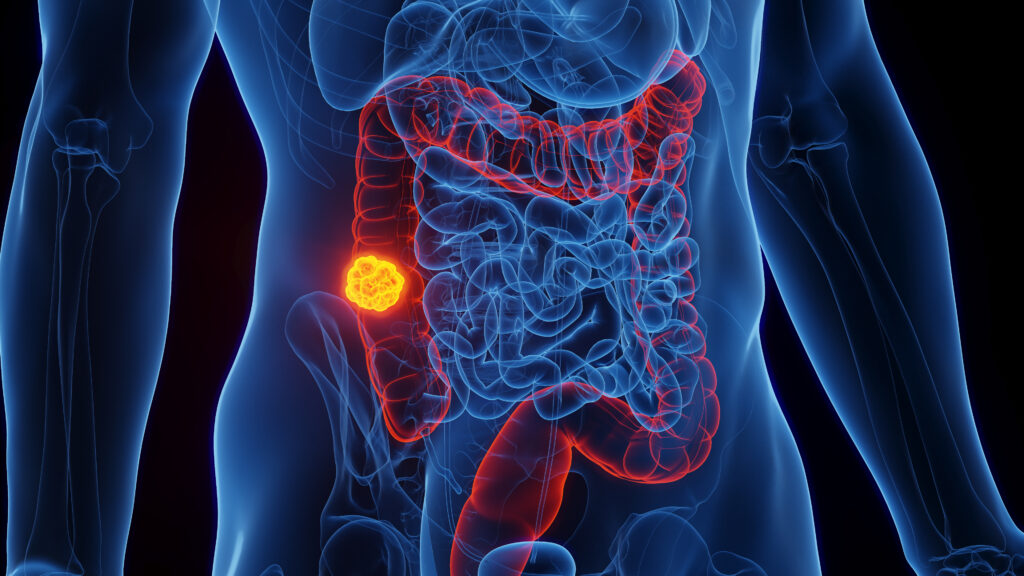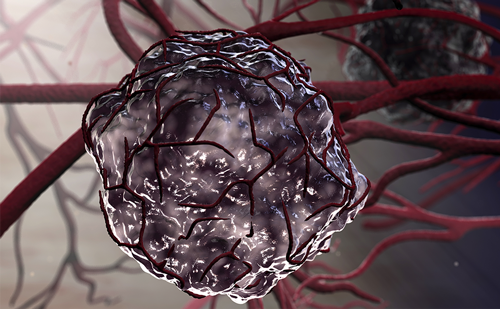A mutation in exon 11, 9, 13 and 17 of the KIT gene is observed in 66%, 13%, 1% and 0.6% of the tumours respectively. Within the PDGFR? gene, mutations of exon 18 or 12 are observed in 5% and 1.5% of the cases.2 GISTs occurring during childhood have a lower incidence of KIT and PDGFR? gene mutations.
For localised tumours, risk assessment profile based on the size and mitotic index per 50 high-power fields remains a standard procedure, although prospective evaluation of a large cohort remains to be performed.5 The prognostic value of World Health Organization (WHO) grading is unclear in GISTs. Other histological and molecular characteristics are suspected to be prognostic parameters, i.e. serosal breaching, primary site and the nature of the mutations in the KIT and PDGFR? genes.
Treatment of Localised and Advanced GIST
The treatment of localised GISTs is surgery. In this setting, adjuvant treatment is experimental.3,4 Conversely, for metastatic or relapsing GISTs, imatinib is the standard treatment while the role of surgery is not known.3,4
For localised tumours, wedge resection of the stomach, or segmental resection of the intestine is considered as an adequate treatment, since GISTs tend to grow out of the primary organ. Adjacent organs adherent to the mass should be resected en bloc with the tumour, in order to avoid capsule rupture and intra-abdominal spillage. Though positive resection margins have not been definitely demonstrated to compromise survival, a reexcision should be considered in case of intramural, intra-lesionally excised tumours, without infiltration of the serosal surface.3,4 Adjuvant imatinib should only be given in randomised clinical trials. Neo-adjuvant imatinib should only be given in inoperable tumours, or in tumours when functionsparing surgery is the goal.3,4
For unresectable and/or metastatic disease, treatment with imatinib should be started immediately even if the tumour is not evaluable. It has not been demonstrated that complete surgical removal of the tumour is useful in this setting.3,4 Imatinib at 400mg per day is the currently recommended first-line treatment in advanced phase, since no overall survival improvement has yet been reported in the two large prospective randomised trials that compared first-line treatment with imatinib in doses of either 400mg and 800mg.6,8 It is worth noting, however, that the largest trial trials reported a superiority in terms of progression-free survival (PFS) in the 800mg arm. This benefit may be restricted to the subsets of patients with mutation in exon 9 of the KIT gene.9 Imatinib interruption is associated with a high risk of relapse, even for patients in complete remission.10 Although most – but not all – patients responded to imatinib reintroduction, the drug should not be discontinued outside of a clinical trial.
How to Identfy a Progression Under Imatinib?
Computed tomography (CT) scanning is currently the imaging modality of choice in response evaluation (III,B). However, Response Evaluation Criteria in Solid Tumours (RECIST) or WHO criteria for response are not always accurate in identifying responders.
Abbreviations: HPF = high-power field.
According to RECIST, in addition to patients in partial response, imatinib is also beneficial in patients with stable disease (i.e. size variation between -30% and +20%) according to conventional tumour response RECIST criteria. It may also help a subset of patients that undergo an initial increase >20% in tumour volume at the early post-treatment phase – that is, within the first six months – despite significant clinical symptomatic improvement or fluorodeoxyglucose positron emission tomography (FDG PET) regression. FDG PET has proven to be highly sensitive in detecting early tumour response, but it is costly and still limited in availability.
When a GIST metastasis responds to imatinib treatment, the mass becomes hypo-attenuated on contrast-enhanced CT and the solid enhancing nodules and tumour vessels decrease within a few months. These patients generally show changes in tumour tissue characteristics on CT scans (i.e. reduction in tumour density measured by Hounsfield Units), or magnetic resonance imaging (MRI), and/or changes in tumour metabolic activity at PET scan (decreased glucose uptake). Clinical symptomatic improvement, CT scan (Hounsfield Unit reduction) and PET scan response are all predictors of tumour control by imatinib.3,4Managing Resistance in Patients with GISTs
there are several options for the management of advanced GISTs. Firstly, however, it is critical to confirm the progression of the tumour as indicated above. Secondly, both identifying the type of progression, whether localised or multi-focal, and discussion of the clinical case in a multidisciplinary setting, are essential in determining therapeutic strategy.
In cases of progression the first important issue is to check that the patient is indeed taking his/her medication appropriately as compliance with the treatment may be suboptimal – compliance studies in the US show that patients typically take around 75% of the drug prescribed. In cases of noncompliance it is essential to impress upon the patient the importance of taking the drug appropriately.
In cases of genuine progression at the dose of imatinib 400mg/day, dose escalation up to 800mg/day is the recommended approach outside of a clinical trial in most clinical practice guidelines.
In cases of focal progression amenable to surgical removal of a progressive metastatic lesion, the role of surgery remains undefined and is not supported by current data. However, studies have shown that complete surgical removal of all lesions performed by an experienced team can result in a median PFS close to six to eight months post-surgery. Additional evaluation of this approach is needed. Surgery is not usually recommended in cases of multi-focal progression.
In countries where available, if dose escalation up to 800mg/day of imatinib fails, sunitinib at the dose of 50mg/day for four weeks followed by two weeks off-treatment is generally recommended. Sunitinib malate (Sutent®) is a multi-target tyrosine kinase inhibitor that was recently approved by the US Food and Drug Administration (FDA) for the treatment of patients with GISTs after failure or intolerance to imatinib based on the recently published results of a phase III trial.
Sunitinib inhibits both KIT and PDGFR? kinases, all three isoforms of the vascular endothelial growth factor receptor (VEGFR1, 2 and 3), Fms-like tyrosine kinase 3 (FLT3) and RET. In this trial, sunitinib, given at 50mg/day for four weeks every six weeks, demonstrated a significant improvement in PFS over placebo, translating into a 50% reduction in the risk of death compared with placebo. However, the control arm in this trial was placebo and some investigators now consider that some patients with focal progression on imatinib still benefit from the drug and its withdrawal might have led to a flare up of sensitive clones in some patients.12
It is worth noting that preliminary results suggest that patients with GIST with mutations of exon 9 or KIT wild type (WT KIT) may have a longer time to progression than patients with exon 11 mutations, while in the latter group, the presence of secondary mutations on exon 13 or 14 is associated with a better outcome than the presence of secondary mutations on exon 17 or 18. This points out possible adaptations of doses of imatinib or selection of secondary agents according to the nature of mutations. A phase II trial is currently investigating a continuous daily dosage of 37.5mg/day sunitinib in imatinib-resistant GIST, based on the observation that some patients seem to experience disease progression during the two-week break of the standard dosing schedule.Other tyrosine kinase inhibitor treatments have been reported useful even in cases where there was progression under imatinib 800mg/day and sunitinib. Molecules are being tested in advanced GISTs, and early results of phase I and phase II trials were reported at the ASCO meeting. These include PTK787/ZK222584 (PTK/ZK) – Novartis AG, Basel, Switzerland and Schering AG, Berlin, Germany – for which results of a phase II trial in patients with imatinib-resistant GISTs was reported at the 2006 ASCO meeting.13 In this study, PTK/ZK was given orally and the reported clinical benefit rate – defined here as complete response+partial response+stable disease (CR+PR+SD) for more than three months – was 67% (10 out of 15 patients).
AMG 706 is another broad spectrum tyrosine kinase inhibitor that was shown to inhibit KIT protein phophorylation in vitro.14 Preliminary results of a phase II trial showing activity in patients with GIST were recently reported at the meeting of the Connective Tissue Oncology Society in November 2006.
Protein kinase C412 (PKC412) is a broad spectrum protein kinase inhibitor, initially developed to target the members of the protein kinase C family, but which was shown to exert inhibitory activity against the kinases of c-KIT, VEGFR and PDGFRs, as well as FLT3. In pre-clinical models, PKC412 was shown to be active against several c-KIT and PDGFR? mutations that are known to be resistant to imatinib. A phase I/II trial of PKC412 in imatinib-resistant GIST was reported at the 2005 ASCO meeting, showing interesting, though very limited, data.15
This study also showed pharmacological interaction between PKC412 and imatinib, requiring the dose of imatinib to be increased from 600 to 1,000mg/day. Nilotinib (formerly ANM 107; Novartis, Basel, Switzerland), which was developed as a second-line therapy for imatinib-resistant chronic myeloid leukemia (CML), seems to show a high efficiency in GISTs where imatinib therapy fails, and combines with a favourable toxicity profile.16 A phase II trial of nilotinib in imatinibresistant GISTs has recently finished accrual, and a phase III trial should soon be launched.
Conclusion
The management of advanced GIST patients has evolved considerably over the last three years. Second-, third- or even fourth-line tyrosine kinase inhibitor treatments are now being explored. Surgery in advanced phases remains experimental in cases of focal progression that is amenable to complete surgical removal. These patients should be managed in specialised multidisciplinary centres.












